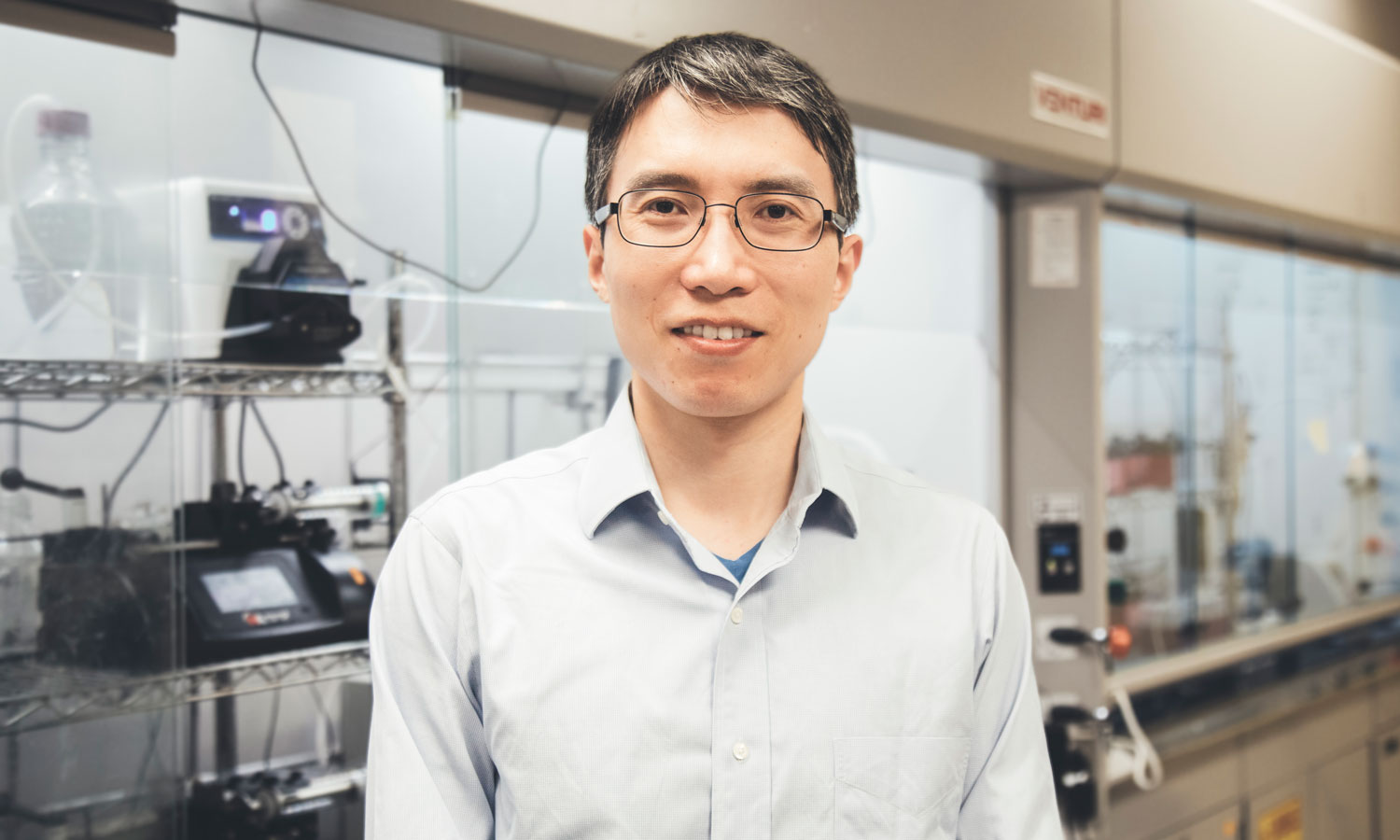Continuous crystallization: How Mo Jiang, Ph.D., creates uniform crystals and microparticles for manufacturing of pharmaceuticals and batteries

Crystalline materials are the base for many everyday products like pharmaceuticals and batteries. Mo Jiang, Ph.D., chemical and life science engineering assistant professor, is researching ways to consistently produce these high-quality crystals using a continuous manufacturing slug flow reactor technique.
“Medicine and batteries have very different functions and chemical compositions, but both product categories share similar manufacturing needs,” said Jiang. “Each material batch must be consistent in order to create a reliable product and scaling that production to larger quantities is also key. Besides chemical composition, the material particle size distribution is also important for product performance and manufacturing efficiency. Take ice cream, for example, its taste can be affected by ice crystal size distribution.”
Making the base materials is typically the first step for product manufacturing and uniformity is important when working with crystals. In pharmaceuticals, for example, lack of uniformity is often associated with inconsistency, and crystal/particle uniformity can also impact the effectiveness of drug delivery. This makes material manufacturing a challenging process because traditional batch-mode crystallization reactors, designed around a beaker or agitated tank, have difficulty creating consistent, uniform crystals.
“For traditional batch-mode crystallization, you may have different local environments within a beaker,” Jiang said. “As solutions of different compositions are added to the same beaker, some parts of the mixture solution may have different compositions than others before becoming fully mixed. This leads to variations in the nucleation and growth process that affect crystal formation and change. These crystal size variations are typically adjusted by milling, but it does not fully solve the problem and adds complexity to the production process.”
Slug flow reactors solve this problem by converting bulk liquid into individual millimeter-size “slugs,” pockets of fluid between gas pushed along tubing by combining the liquid solution and gas through a simple connector. Each slug becomes a miniature reactor that is self-stirred by intrinsic recirculation, which is the natural flow pattern as the slug moves. Molecules or ions are assembled directly into uniform microcrystals or microparticles within the flowing slugs. They have very high uniformity and can be reproduced at flexible manufacturing scales.
“The slug has a small volume, which means temperature, concentration and other conditions needed for crystallization can be spatially uniform,” said Jiang. “ Using fluid mechanics, we can continuously make uniform slugs within tubing. That means the resultant crystals from each slug will likely be of a similar high quality, and scaling up quantities can be achieved without changing equipment by simply increasing the number of slugs in the tube. If you operate the process continuously, more product is created.”
Ram Gupta, Ph.D., associate dean for research and chemical and life science engineering professor, is one of Jiang’s collaborators and encouraged him to pursue funding from the National Science Foundation for the slug flow continuous crystallization idea. Jiang has also worked with Frank Gupton, Ph.D., chemical and life science engineering department chair and Floyd D. Gottwald Chair of pharmaceutical engineering, to develop a continuous production process for rifapentine, focused toward the long-term goal of treating tuberculosis in Africa. With his collaborators, Jiang published his innovations on slug flow production of uniform crystals in multiple journals like the American Chemical Society’s Applied Energy Materials, Materials Today Energy, Energy and Fuel, the Journal of Materials Chemistry A and the Journal of Alloys and Compounds.
“Fifteen years ago, I was using a huge beaker to generate a large amount of particles,” Jiang said. “My experiment changed color as the solution mixed and I noticed the change wasn’t happening uniformly. My first thought was I did something wrong, but after months of repeated experiments, I concluded the discrepancy was likely caused by another factor. It was spatial non-uniformity where the beaker of solution contained many microenvironments and not all of them had optimal conditions for crystal growth.”
Jiang’s curiosity formed into a research career that brought him to the VCU College of Engineering.
“I have noticed this particle non-uniformity phenomena in many different systems,” Jiang said. “Crystals or particles of amino acids, proteins and lipids are some examples of biopharmaceutical materials that may benefit from improving particle uniformity and reproducibility. The same can be true for inorganic materials like metal oxides used in lithium-ion batteries. I collaborate with researchers from different application fields to better understand and address this non-uniformity phenomenon.”
These collaborations are a unique characteristic of Jiang’s lab. He also works with undergraduate students outside the VCU College of Engineering, mainly from chemistry and biology, because continuous crystallization technology has widespread use. Within the college, Jiang also works with biomedical engineering undergraduates, in addition to those from chemical and life science engineering. Many of these students have gone on to win awards and co-author journal articles. They have been supported by the National Science Foundation, Department of Energy, U.S. Pharmacopia and Boehringer-Ingelheim Pharmaceuticals Inc. Each of Jiang’s students plan to apply the slug flow crystallization technology in their future careers.
“I welcome students from all disciplines,” Jiang said. “As long as they are interested in the research, the student deserves an opportunity. I do my best to create that opportunity for them and cultivate their interests.”
The Department of Chemical and Life Science Engineering provides undergraduate and graduate students with the opportunity to perform real-world research as soon as they enroll. From delving into the intricacies of pharmaceutical manufacturing to exploring the effects of climate change through heat studies, our students pursue a diverse range of cutting-edge research topics. Browse videos and recent news from the Department of Chemical and Life Science Engineering to discover how the College of Engineering at Virginia Commonwealth University prepares the next generation of scientists and engineers for the challenges of the future.
Categories Chemical & Life Science Engineering